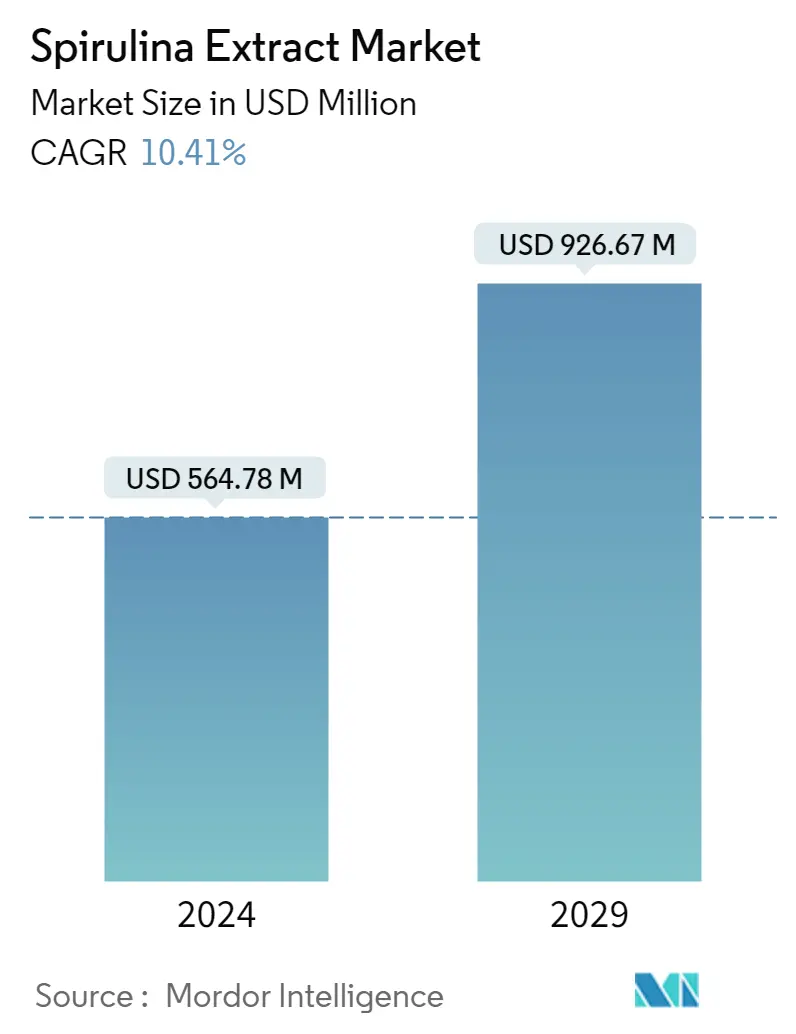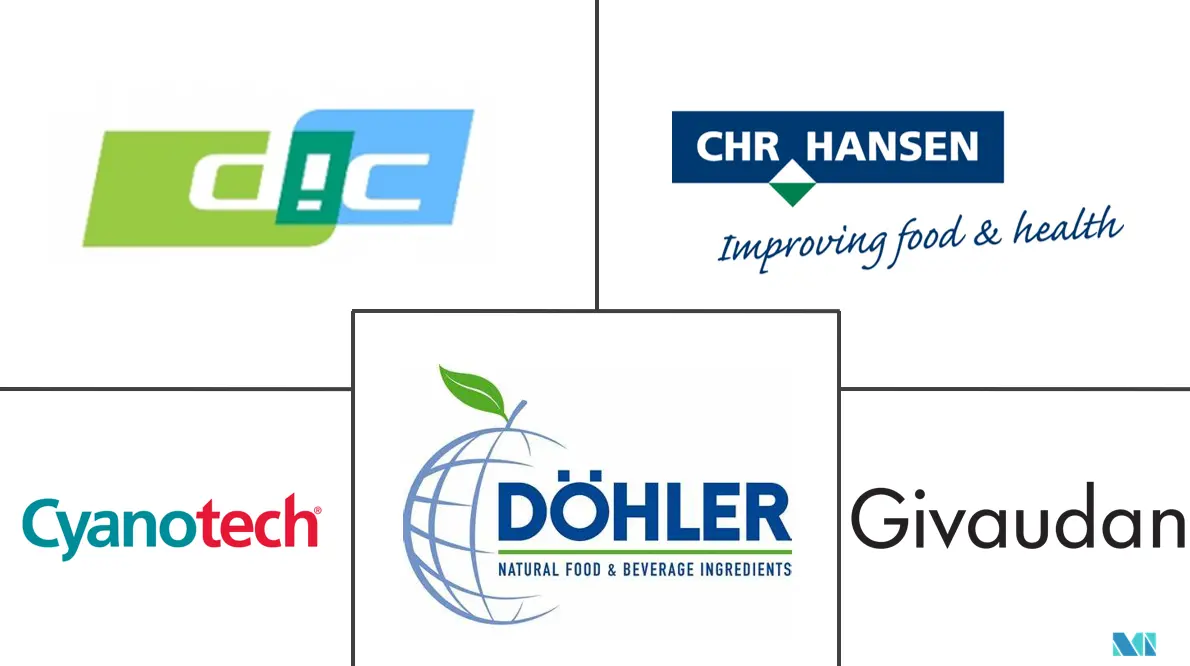Market Size of Spirulina Extract Industry

| Study Period | 2019 - 2029 |
| Market Size (2024) | USD 564.78 Million |
| Market Size (2029) | USD 926.67 Million |
| CAGR (2024 - 2029) | 10.41 % |
| Fastest Growing Market | Asia Pacific |
| Largest Market | North America |
Major Players
*Disclaimer: Major Players sorted in no particular order |
Need a report that reflects how COVID-19 has impacted this market and its growth?
Spirulina Extracts Market Analysis
The Spirulina Extract Market size is estimated at USD 564.78 million in 2024, and is expected to reach USD 926.67 million by 2029, growing at a CAGR of 10.41% during the forecast period (2024-2029).
Spirulina is extracted from different sources like microalgae, plants, and flowers. Spirulina is rich in different compounds like phycocyanin, phenolics, and polysaccharides. it gives antioxidant, anti-inflammatory, and immunostimulating effects. Spirulina can be used in different applications like in foods, pharmaceuticals, cosmetics, and personal care products. The growing demand for natural and clean label colors is expected to create a demand for spirulina extracts. Moreover, manufacturers are in the process of developing beverages based on Spirulina which is still not available in the market. This development is expected to create new business segments once introduced into the market. Only a few Spirulina juices and smoothies are available in a few regions under the beverage segment. For instance, in December 2021, Ful launched the Ful Spirulina Fizz range, a non-alcoholic soft drink in the United Kingdom.
Manufacturers are also exploring the potential of spirulina in cosmetics. Recently, microalgae have been used to treat various skin problems like tanning, aging, and pigment disorders. Additionally, Spirulina can also be used in the areas like skin whitening and anti-aging. Algae species are already being used in a few cosmetic formulations like moisturizing and thickening agents. For instance, in August 2021, the Algenist brand launched spirulina-based vitamin C skin brightening serum. However, stringent regulations and a ban on synthetic food additives by the European and the United State governments have opened the gates for the demand for natural additives. Over the medium term, the market is expected to grow owing to the increasing demand for natural and clean-labeled ingredients.
Spirulina Extracts Industry Segmentation
Spirulina is rich in chlorophyll, phycocyanin, and beta-carotene and is often used as a source of natural color. Edible color Linablue, used in ice creams and confectionaries, is mainly produced from spirulina. The spirulina extract market is segmented by applications into nutraceuticals, food, cosmetics, agriculture, feed, and others. By formulation, the spirulina extract market is segmented into powder, tablet & capsule, liquid, and granule. The market is segmented by geography into North America, Europe, Asia-Pacific, South America, the Middle East & Africa. For each segment, the market sizing and forecasts have been done on the basis of value (in USD million).
| Application | |
| Nutraceuticals | |
| Food | |
| Cosmetics | |
| Agriculture | |
| Feed | |
| Others |
| Formulation | |
| Powder | |
| Tablet & Capsule | |
| Liquid | |
| Granule |
| Geography | |||||||||
| |||||||||
| |||||||||
| |||||||||
| |||||||||
|
Spirulina Extract Market Size Summary
The Spirulina Extract Market is poised for significant growth, driven by the increasing demand for natural and clean-label ingredients across various industries. Spirulina, a microalgae rich in compounds like phycocyanin, phenolics, and polysaccharides, is gaining traction for its antioxidant, anti-inflammatory, and immunostimulating properties. Its applications span food, pharmaceuticals, cosmetics, and personal care products, with a notable rise in demand for natural food colorings due to health concerns over synthetic additives. The market is witnessing innovation, such as the development of spirulina-based beverages and cosmetics, which are expected to create new business segments. Regulatory support for natural additives further bolsters market expansion, as consumers increasingly prefer products with clean labels and natural ingredients.
The market landscape is characterized by a mix of global and regional players, with companies like DIC Corporation, Cyanotech Corporation, Dohler Group, Chr Hansen A/S, and Givaudan leading the charge. These players are engaging in strategic activities such as product development, mergers, acquisitions, and partnerships to enhance their market position. The North American region, in particular, is seeing a surge in demand for spirulina extract in cosmetics and personal care products, driven by rising disposable incomes and consumer awareness of product ingredients. The market's fragmented nature and the ongoing introduction of new spirulina products, in line with regulatory approvals, indicate a dynamic and competitive environment poised for continued growth.
Spirulina Extract Market Size - Table of Contents
-
1. MARKET DYNAMICS
-
1.1 Market Drivers
-
1.2 Market Restraints
-
1.3 Porter's Five Forces Analysis
-
1.3.1 Threat of New Entrants
-
1.3.2 Bargaining Power of Buyers/Consumers
-
1.3.3 Bargaining Power of Suppliers
-
1.3.4 Threat of Substitute Products
-
1.3.5 Intensity of Competitive Rivalry
-
-
-
2. MARKET SEGMENTATION
-
2.1 Application
-
2.1.1 Nutraceuticals
-
2.1.2 Food
-
2.1.3 Cosmetics
-
2.1.4 Agriculture
-
2.1.5 Feed
-
2.1.6 Others
-
-
2.2 Formulation
-
2.2.1 Powder
-
2.2.2 Tablet & Capsule
-
2.2.3 Liquid
-
2.2.4 Granule
-
-
2.3 Geography
-
2.3.1 North America
-
2.3.1.1 United States
-
2.3.1.2 Canada
-
2.3.1.3 Mexico
-
2.3.1.4 Rest of North America
-
-
2.3.2 Europe
-
2.3.2.1 United Kingdom
-
2.3.2.2 Germany
-
2.3.2.3 France
-
2.3.2.4 Russia
-
2.3.2.5 Italy
-
2.3.2.6 Spain
-
2.3.2.7 Rest of Europe
-
-
2.3.3 Asia-Pacific
-
2.3.3.1 India
-
2.3.3.2 China
-
2.3.3.3 Japan
-
2.3.3.4 Australia
-
2.3.3.5 Rest of Asia-Pacific
-
-
2.3.4 South America
-
2.3.4.1 Brazil
-
2.3.4.2 Argentina
-
2.3.4.3 Rest of South America
-
-
2.3.5 Middle-East and Africa
-
2.3.5.1 United Arab Emirates
-
2.3.5.2 South Africa
-
2.3.5.3 Rest of Middle-East and Africa
-
-
-
Spirulina Extract Market Size FAQs
How big is the Spirulina Extract Market?
The Spirulina Extract Market size is expected to reach USD 564.78 million in 2024 and grow at a CAGR of 10.41% to reach USD 926.67 million by 2029.
What is the current Spirulina Extract Market size?
In 2024, the Spirulina Extract Market size is expected to reach USD 564.78 million.

